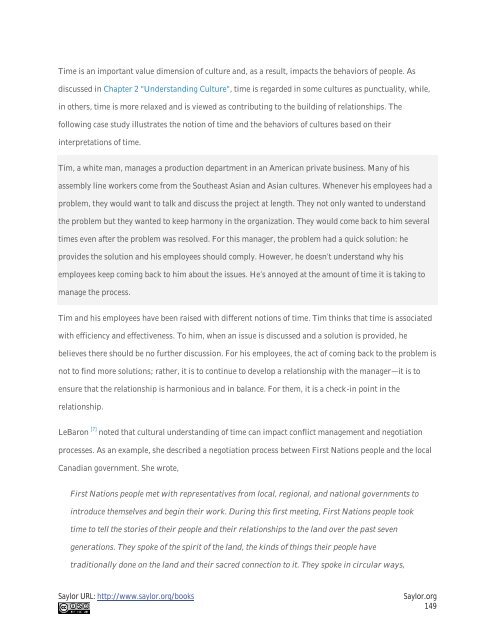Leading with Cultural Intelligence, 2012a
Leading with Cultural Intelligence, 2012a
Leading with Cultural Intelligence, 2012a
Create successful ePaper yourself
Turn your PDF publications into a flip-book with our unique Google optimized e-Paper software.
Time is an important value dimension of culture and, as a result, impacts the behaviors of people. As<br />
discussed in Chapter 2 "Understanding Culture", time is regarded in some cultures as punctuality, while,<br />
in others, time is more relaxed and is viewed as contributing to the building of relationships. The<br />
following case study illustrates the notion of time and the behaviors of cultures based on their<br />
interpretations of time.<br />
Tim, a white man, manages a production department in an American private business. Many of his<br />
assembly line workers come from the Southeast Asian and Asian cultures. Whenever his employees had a<br />
problem, they would want to talk and discuss the project at length. They not only wanted to understand<br />
the problem but they wanted to keep harmony in the organization. They would come back to him several<br />
times even after the problem was resolved. For this manager, the problem had a quick solution: he<br />
provides the solution and his employees should comply. However, he doesn’t understand why his<br />
employees keep coming back to him about the issues. He’s annoyed at the amount of time it is taking to<br />
manage the process.<br />
Tim and his employees have been raised <strong>with</strong> different notions of time. Tim thinks that time is associated<br />
<strong>with</strong> efficiency and effectiveness. To him, when an issue is discussed and a solution is provided, he<br />
believes there should be no further discussion. For his employees, the act of coming back to the problem is<br />
not to find more solutions; rather, it is to continue to develop a relationship <strong>with</strong> the manager—it is to<br />
ensure that the relationship is harmonious and in balance. For them, it is a check-in point in the<br />
relationship.<br />
LeBaron [7] noted that cultural understanding of time can impact conflict management and negotiation<br />
processes. As an example, she described a negotiation process between First Nations people and the local<br />
Canadian government. She wrote,<br />
First Nations people met <strong>with</strong> representatives from local, regional, and national governments to<br />
introduce themselves and begin their work. During this first meeting, First Nations people took<br />
time to tell the stories of their people and their relationships to the land over the past seven<br />
generations. They spoke of the spirit of the land, the kinds of things their people have<br />
traditionally done on the land and their sacred connection to it. They spoke in circular ways,<br />
Saylor URL: http://www.saylor.org/books<br />
Saylor.org<br />
149


















